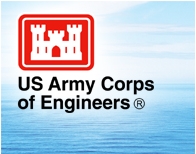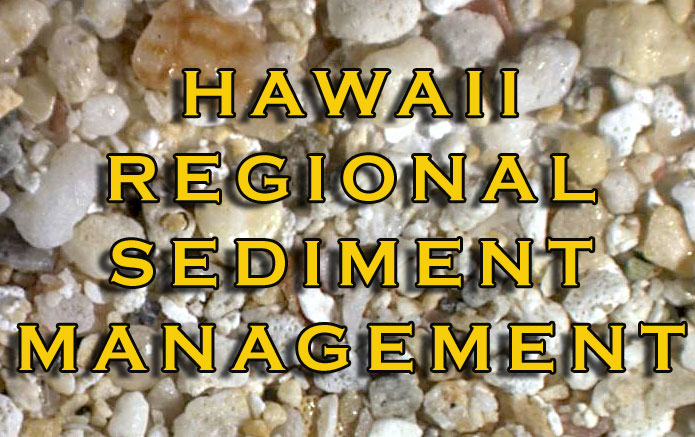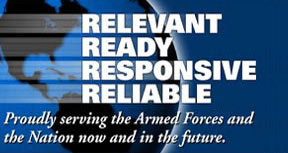Goals of the Waikiki Beach Potential RSM Project (PRP) include the coordination of Federal, State and local efforts to nourish and maintain the beaches in this highly utilized urban setting. Federal interest in the area involves the Waikiki Area Erosion project and the Ala Wai Watershed study. The State of Hawai‘i is currently studying the sustainability of utilizing offshore sediment resources to nourish the Waikiki shoreline. The City and County of Honolulu is recommending the creation of a recreational beach within the footprint of the Natatorium War Memorial. Private property owners have also proposed shore protection projects within the area. D2P/RSM studies are focused on facilitating the efficient and effective use of these resources toward the common goal of improving the quality of beaches throughout the entire region.
Federal Interest: The Waikiki Area Erosion project was authorized under the River and Harbor Act of 1965. The goal of the project is to provide for a stable protective beach that is both publicly and environmentally acceptable. The authorized plan includes restoring and protecting approximately 10,800 feet of shoreline along Waikiki Beach from Duke Kahanamoku Beach to the Elks Club. Two of the eight project reaches authorized for construction in 1965 have been implemented to date. The Fort DeRussy reach was completed in 1971 with non-appropriated military funds. Construction of the Kuhio Beach sector was completed by the State of Hawai‘i in 1972. Construction of the uncompleted portions of the authorized project is currently estimated at $24,000,000.
The Federally authorized Waikiki Area Erosion project is currently in the Preconstruction and Engineering (PED) phase. However, because of a lack of funds the project has been suspended. The project sponsor, State DLNR, has solicited assistance from the Hawai‘i delegation in the project implementation process. A study recommending Federal participation in the PED phase was submitted to Headquarters, U.S. Army Corps of Engineers (HQ USACE) in November 2002. The study concluded that the project, as authorized, fulfills the current day needs at Waikiki Beach and is economically justified based on estimated National Economic Development (NED) benefits exceeding project costs. However, the economic justification was based on recreation benefits, considered a low administration budget priority, and visitor expenditures which are not recognized as a NED benefits. Subsequently, the State has decided to pursue design and construction of a locally funded Waikiki Beach shore protection project.
State Of Hawai‘i Interest: There are two main State concerns regarding ongoing erosion of the beach at Waikiki. In addition to the loss of beach width, and associated effects on tourism, the process of offshore sand migration may have environmental impacts on benthic flora and fauna, the filling of holes on the reef top, changes to bottom feeding fish habitats, and its impact on wave breaks and surf sites.
Beach restoration using near-shore sand sources will minimize the environmental impact of onshore and offshore sand transport. However, a single restoration is not considered a permanent solution because of the ongoing erosion.
The State Office of Conservation and Coastal Lands (OCCL) desires to replenish sand that has been lost from the beach to the near-shore area through an ongoing sand maintenance effort. This “recycling” strategy can be an efficient method of maintaining a recreational beach in Waikiki as well as minimizing the environmental effects of sediment brought into the Waikiki marine ecosystem over the last 50 years. Measures to improve sand management will include, but not be limited to, the periodic identification, mapping, and analysis of offshore sand deposits, extraction of this material, and periodic beach restoration.
Two primary objectives for this work are: 1) obtaining an approved environmental impact statement for periodic beach restoration and maintenance of Waikiki Beach and its supporting activities, and 2) design, permitting, and the preparation of construction documents for beach restoration and maintenance at Waikiki Beach.
City and County of Honolulu Interests: The City and County of Honolulu currently plans to demolish the derelict Natatorium pool and bleachers, while relocating the historic entryway arches inland. Approximately 330 feet of beach will be restored in the pool location. Based on the need for an Environmental Impact Statement and the level of public interest involved, the process is likely to take several years.
Private Interests: Kyo-Ya Hotels and Resorts, owners of the Sheraton Waikiki Hotel, plans to restore and stabilize Gray’s Beach. The planned project would place 15,000 cubic yards of sand on the beach, adding 75 feet of beach width along the 500-foot shoreline fronting the Sheraton Waikiki. Near-shore sand sources would be dredged and placed on the beach, and low-profile rock T-groins would be constructed to retain the sand.
Waikiki Beach PRP: The following activities are being pursued in association with the Waikiki Beach PRP. These activities will be developed contingent upon the receipt of additional funding.
· Offshore Geophysical Sand Source Investigations:
- University of Hawai‘i Offshore Sand Source Investigations
- State of Hawai‘i Proposed Borrow Areas
· D2P Regional Sediment Budget (RSB):
- A RSB has been developed that incorporates the Waikiki Beach littoral cell. Further development of the D2P RSB will help identify problem areas and sustainable offshore sand sources.
· D2P/RSM Workshops:
- A series of workshops will be conducted to facilitate development of RSM strategies to nourish the beaches in the Waikiki area.
· Fort DeRussy Sand Back-passing:
- Erosion along the Fort DeRussy Beach shoreline currently threatens to expose the seawall facing the sidewalk which extends along the full length of this Federally owned parcel. Beach width are narrow (on the order of 30 feet) at the Diamond Head side of the reach. Wave over-wash and sedimentation on the landward side of the beach are problematic where beach widths are narrow. In contrast, at the Ewa side of the reach, beach widths are as great as 270 feet. Since the predominant sediment transport direction is from east to west along this portion of the Waikiki Beach shoreline, sand back-passing is proposed to provide a more even distribution of sediment and uniform protection of upland development at the Fort DeRussy parcel.
The map here shows the various components of a recent shoreline inventory conducted between the Sheraton Waikiki Hotel and the Ala Wai Yacht Harbor. The red line depicts the approximate location of the mean high water shoreline during the time of the inventory. The black line shows the location of the sidewalk that demarks the limit of the sandy beach. At Fort DeRussy Beach, the sidewalk is fronted by a low crested seawall. The seawall provides protection against undermining of the sidewalk, but wave frequently over-wash the structure and inundate upland areas.
Facilitation of sand back-passing from west to east at Fort DeRussy Beach is a component of the Waikiki Beach PRP. Partners in this effort will include the U.S. Army’s Hale Koa Hotel, Hilton Hawaiian Hotel, Federal and State resource agencies, POH as well as other stakeholders.



